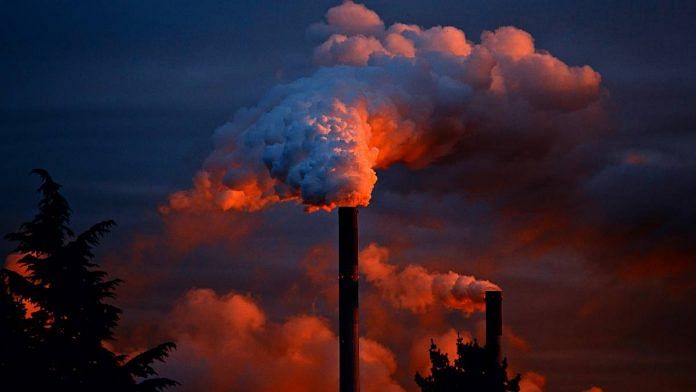New Delhi: India’s fossil fuel imports and bills are likely to double over the next two decades owing to the scale of its development, according to the latest World Energy Outlook report by the International Energy Agency (IEA).
The IEA’s World Energy Outlook released Thursday added that India’s demand for energy will rise by more than three per cent per year if current energy policies continue to be in place — “the largest increase in energy demand of any country”. While a majority of India’s electricity comes from coal, in 2021-2022, petroleum and its products accounted for over 19 per cent of total imports.
According to India’s power ministry, 42 per cent of the country’s installed electric generation capacity currently comes from non-fossil sources. However, the twin forces of urbanisation and industrialisation will cause India’s energy demands to swell further, outpacing its deployment of renewable energy sources, said the report.
“Even though India continues to make great strides with renewables deployment and efficiency policies, the sheer scale of its development means that the combined import bill for fossil fuels doubles over the next two decades,” said the report. Oil will continue to be the largest import component, pointing to “continued risks to energy security”, it added.
The world’s energy scenario is currently in a state of crisis, said the IEA, sparked by Russia’s invasion of Ukraine. Governments across the world are faced with high fuel prices and energy shortfalls, pushing millions into energy poverty, added the report.
The crisis, however, is likely to be temporary, with the share of fossil fuels in the global energy mix slated to fall from around 80 per cent to below 60 per cent in 2050, the report stated.
Emissions from fossil fuels are the the biggest human contributor to global heating. The report comes ahead of the world’s largest annual climate summit — the COP 27 in Egypt next month — where countries will deliberate on how to limit global warming to “well below” 2 degrees Celsius above pre-industrial levels, exceeding which the effects of climate change will be catastrophic.
India’s updated climate goals include a pledge to achieve about 50 per cent cumulative electric power capacity from non-fossil sources by 2030, contingent upon international funding and technology transfer. The report noted that India’s ambition to achieve net-zero emissions by 2070 will bring the world closer to limiting global warming than before.
“Amid the major changes taking place, a new energy security paradigm is needed to ensure reliability and affordability while reducing emissions,” said Dr Fatih Birol, executive director of the International Energy Agency in a statement.
According to the report, global investments in clean energy will need to rise to $4 trillion by 2030 compared to the current $1.3 trillion, to reach net-zero emissions by mid-century. These investments need to be directed to emerging economies, the report notes.
“The cost of capital for a solar PV plant in 2021 in key emerging economies was between two‐ and three‐times higher than in advanced economies and China. Today’s rising borrowing costs could exacerbate the financing challenges facing such projects, despite their favourable underlying costs. A renewed international effort is needed to step up climate finance and tackle the various economy‐wide or project‐specific risks that deter investors,” says the report.
On top of the high costs of renewables, low-income countries are bearing the brunt of climate change, and are demanding their richer counterparts pay for the losses and damages arising from global warming.
Also read: UN report has grim warning on global warming: Latest pledges ‘nowhere near’ meeting targets
India’s per capita emissions below world average
According to the IEA, India’s coal generation is projected to rise and peak around 2030 if current policies continue, though “its share of electricity generation falls from just below 75% to 55%”.
During the COP26 last year, India was among the countries that insisted coal be “phased down” as opposed to “phased out”, citing the common but differentiated responsibilities of addressing climate change — a principle that states countries are not equally responsible for global warming.
The latest United Nations Emissions Gap Report released Thursday shows India’s per capita emissions — at 2.3 tonnes — are far below the world average of 6.3 tonnes. The United States is the foremost contributor to historical emissions, responsible for climate change today, followed by the (formerly) 28 countries of the European Union. Per capita emissions in the U.S. continue to be the highest, at 14 tonnes, according to the United Nations Environment Programme (UNEP).
The IEA report noted that schemes like India’s Gati Shakti National Master Plan, which seeks to integrate infrastructure across various economic zones, and the Atma Nirbhar Bharat scheme, which seeks to reduce India’s imports, “underpin robust growth in renewables and electric mobility”, by 2030.
By that year, renewables “meet more than 60% of the growth in demand for power, and account for 35% of the electricity mix,” with solar PV alone accounting for more than 15%, the report said.
It added that if India is able to achieve all its announced pledges, “more rapid progress in deploying low‐emissions alternatives in power, industry and transport sectors, in particular, puts India on a trajectory in line with its goal of net zero emissions by 2070″.
(Edited by Poulomi Banerjee)
Also read: State bodies ‘ill equipped’ to handle air pollution in ‘most-polluted’ Gangetic plain, finds study



